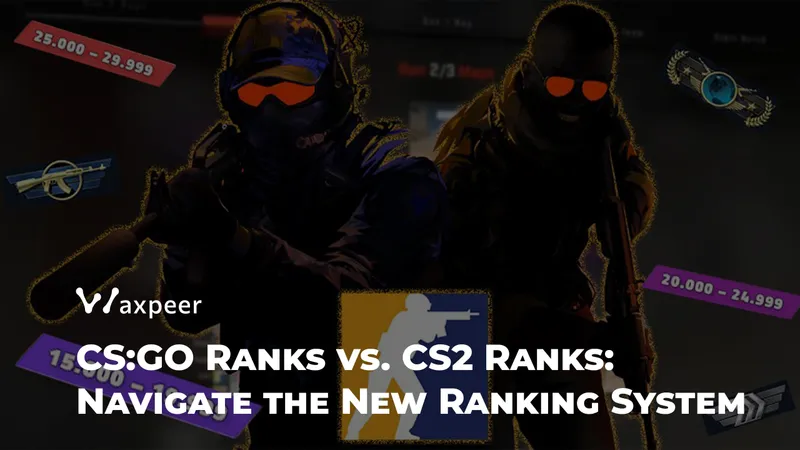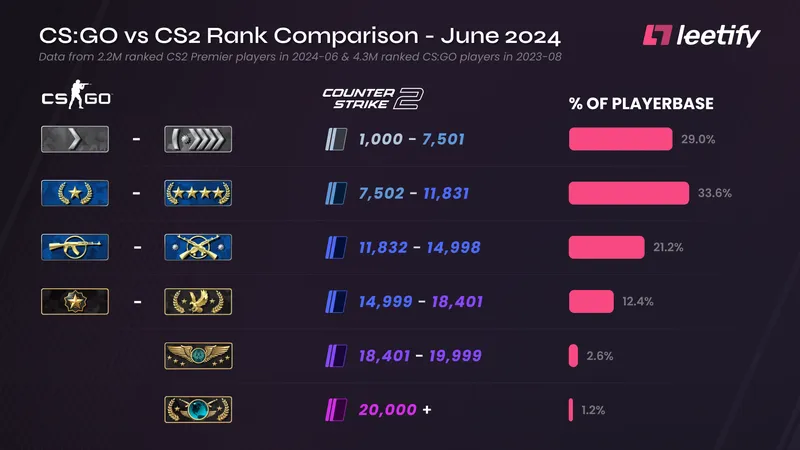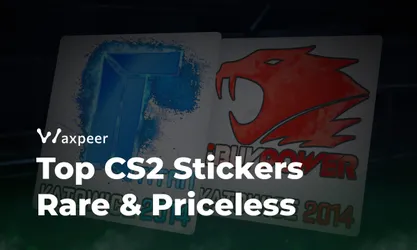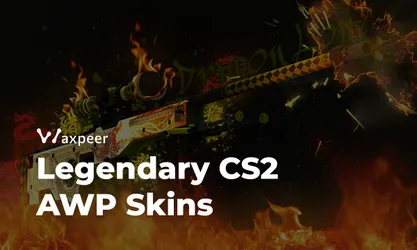CS:GO Ranks vs. CS2 Ranks: Understanding the New Ranking System
Explore how CS:GO ranks translate to CS2's new ranking system. Understand the differences between CS:GO's ranks and CS2's Counter-Strike Rating to gauge your skill level in the latest installment.

With the release of Counter-Strike 2, players are eager to understand how the new ranking system compares to the familiar ranks in Counter-Strike: Global Offensive. Whether you're a seasoned veteran or new to the series, knowing how your rank translates between the two games can help you gauge your skill level and set goals for improvement. In this article, we'll delve into the differences between CS:GO ranks and CS2's new ranking system and provide insights on how they correlate.
Understanding CS:GO's Ranking System
In CS:GO, the ranking system is based on a hidden Competitive Skill Group (CSG) algorithm, which places players into one of 18 ranks, from Silver I to The Global Elite. Your rank is determined by your performance in competitive matches, taking into account factors like wins, losses, individual performance, and the skill level of opponents.
CS:GO Ranks Overview
Silver I
Silver II
Silver III
Silver IV
Silver Elite
Silver Elite Master
Gold Nova I
Gold Nova II
Gold Nova III
Gold Nova Master
Master Guardian I
Master Guardian II
Master Guardian Elite
Distinguished Master Guardian
Legendary Eagle
Legendary Eagle Master
Supreme Master First Class
The Global Elite
Introducing CS2's Ranking System

CS2 brings a fresh approach to player rankings with its new Premier Mode and the Counter-Strike Rating (CSR) system. Unlike CS:GO's rank tiers, CS2 utilizes a numerical rating system that represents a player's skill level more precisely. This ELO-based system assigns a rating point value, allowing for more granular matchmaking and progression tracking.
Key Features of CS2's Ranking System
Numerical Ratings: Players receive a CSR score, typically ranging from 1,000 to 35,000 or higher.
Premier Mode: A competitive environment where players can climb the ranks based on their CSR.
Seasonal Resets: Rankings may reset each season to keep the competition fresh.
Comparing CS:GO Ranks to CS2 Ratings

While the two systems differ fundamentally, many players are curious about how their CS:GO rank might translate to a CS2 CSR score. Below is an approximate comparison to help you understand where you might stand in CS2 based on your CS:GO rank.
Approximate Rank Conversion
Silver Ranks (CSR 1,000 – 5,000)
Silver I: 1,000 – 2,000 CSR
Silver II: 2,000 – 3,000 CSR
Silver III: 3,000 – 4,000 CSR
Silver IV: 4,000 – 5,000 CSR
Silver Elite Ranks (CSR 5,000 – 7,000)
Silver Elite: 5,000 – 6,000 CSR
Silver Elite Master: 6,000 – 7,000 CSR
Gold Nova Ranks (CSR 7,000 – 11,000)
Gold Nova I: 7,000 – 8,000 CSR
Gold Nova II: 8,000 – 9,000 CSR
Gold Nova III: 9,000 – 10,000 CSR
Gold Nova Master: 10,000 – 11,000 CSR
Master Guardian Ranks (CSR 11,000 – 15,000)
Master Guardian I: 11,000 – 12,000 CSR
Master Guardian II: 12,000 – 13,000 CSR
Master Guardian Elite: 13,000 – 14,000 CSR
Distinguished Master Guardian: 14,000 – 15,000 CSR
Legendary Ranks (CSR 15,000 – 18,000)
Legendary Eagle: 15,000 – 16,500 CSR
Legendary Eagle Master: 16,500 – 18,000 CSR
Elite Ranks (CSR 18,000+)
Supreme Master First Class: 18,000 – 20,000 CSR
The Global Elite: 20,000+ CSR
Note: These ranges are approximate and based on community observations. The actual CSR may vary depending on individual performance and matchmaking factors.
Factors Influencing Rank Differences
Several factors can affect how your CS:GO rank translates to your CS2 rating:
1. Different Ranking Algorithms
CS:GO and CS2 use different algorithms to calculate player skill. CS2's CSR aims for a more precise measurement, which might result in different placements compared to CS:GO.
2. Changes in Player Base
With the transition to CS2, the player base dynamics have shifted. New players may join, and some CS:GO veterans might take a break, affecting the overall skill distribution.
3. Personal Skill Development
Your own skills may have improved or declined over time. Factors like adapting to new game mechanics, maps, and weapon balancing in CS2 can influence your performance.
4. Calibration Matches
CS2 may require you to play calibration matches to determine your initial CSR. Performance in these matches heavily influences your starting rating.
Tips to Improve Your CS2 Rating
Practice Regularly: Consistent gameplay helps you adapt to CS2's mechanics.
Learn New Maps: Familiarize yourself with any new or updated maps in CS2.
Study Game Mechanics: Understand changes in weapons, recoil patterns, and utility usage.
Communicate with Your Team: Effective teamwork often leads to better match outcomes.
Review Your Matches: Analyze your gameplay to identify areas for improvement.
Enhance Your CS2 Experience with Waxpeer
Looking to stand out in your matches? Visit Waxpeer for a vast selection of CS2 skins and items. Customize your loadout and make a statement on the battlefield.
Transitioning from CS:GO to CS2 introduces new challenges and opportunities. Understanding how the ranking systems compare can help you set realistic expectations and goals. Remember that rankings are just a reflection of your performance at a given time. Keep practicing, stay updated with game changes, and most importantly, enjoy the game!





